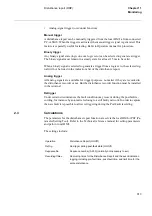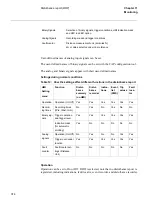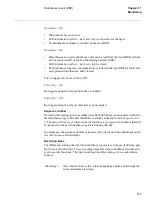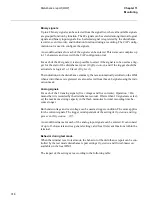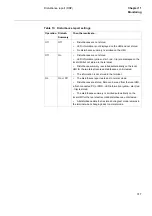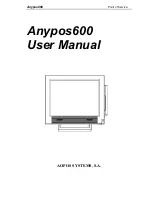
312
Disturbance report (DRP)
&KDSWHU
0RQLWRULQJ
The check of the trigger condition is based on peak-to-peak values. When this is found,
the absolute average value of these two peak values is calculated. If the average value
is above the threshold level for an overvoltage or overcurrent trigger, this trigger is in-
dicated with a greater than (>) sign with the user-defined name.
If the average value is below the set threshold level for an undervoltage or undercurrent
trigger, this trigger is indicated with a less than (<) sign with its name. The procedure
is separately performed for each channel.
This method of checking the analog start conditions gives a function which is insensi-
tive to DC offset in the signal. The operate time for this start is typically in the range of
one cycle, 20 ms for a 50 Hz network.
The analog signals are presented only in the disturbance recording, but they affect the
entire disturbance report when being used as triggers.
%LQDU\VLJQDOV
Up to 48 binary signals can be selected from the signal list, where all available signals
are grouped under each function. The 48 signals can be selected from internal logical
signals and binary input signals. Each of the 48 signals can be selected as a trigger of
the disturbance report. It is also possible to set if the trigger should be activated on a
logic 1 or a logic 0. A binary signal can be selected to activate the red LED on the local
HMI.
A user-defined name for each of the signals can be programmed in the terminal.
The selected 48 signals are presented in the event list and the disturbance recording. But
they affect the whole disturbance report when they are used as triggers.
The indications, that are to be automatically scrolled on the HMI when a disturbance
has been recorded are also selected from these 48 signals with the HMI Indication
Mask.
7ULJJHUVLJQDOV
The trigger conditions affect the entire disturbance report. As soon as a trigger condition
is fulfilled, a complete disturbance report is recorded. On the other hand, if no trigger
condition is fulfilled, there is no disturbance report, no calculation of distance to fault,
no indications, and so on. This implies the importance of choosing the right signals as
trigger conditions.
A trigger can be of type:
•
Manual trigger
•
Binary-signal trigger
Summary of Contents for REO 517
Page 10: ... RQWHQWV ...
Page 16: ...6 Introduction to the application manual KDSWHU QWURGXFWLRQ ...
Page 64: ...54 Blocking of signals during test KDSWHU RPPRQ IXQFWLRQV ...
Page 88: ...78 Scheme communication logic ZCOM KDSWHU LQH LPSHGDQFH ...
Page 146: ...136 Unbalance protection for capacitor banks TOCC KDSWHU XUUHQW ...
Page 166: ...156 Dead line detection DLD KDSWHU 3RZHU V VWHP VXSHUYLVLRQ ...
Page 378: ...368 Monitoring of DC analog measurements KDSWHU 0RQLWRULQJ ...
Page 384: ...374 Pulse counter logic PC KDSWHU 0HWHULQJ ...
Page 412: ...402 Serial communication modules SCM KDSWHU DWD FRPPXQLFDWLRQ ...
Page 440: ...430 LED indication module KDSWHU DUGZDUH PRGXOHV ...
















